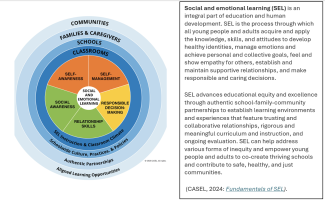STRUCTURE OF OUR TEACHERS' SEL CENTER
Building on the work that has been done in regard to understanding and addressing SEL, we have divided our resources into different sub-sections.
Based largely on findings from the research literature, we examine three different underlying areas of concern related to teachers’ SEL:
SOURCES OF STRESS AND BURNOUT
The causes of teacher burnout are various and deeply entrenched. We assembled research-based information on some of the main areas of concern.
IMPACT ON STUDENTS
There is considerable evidence that teachers’ stress and burnout has a substantial impact on students and vice-versa. This contributes to the urgency of addressing the wellness of teachers.
GAP IN TEACHER EDUCATION AND PROFESSIONAL DEVELOPMENT
There is considerable evidence that teacher education programs, in particular, underaddress SEL, leaving new teachers underprepared in this area. However, there is a growing list of resources on how this gap can be addressed.
We consider four aspects of the daily life of teachers that are particularly subject to stress and burnout:
ATTENDING TO PERSONAL WELLBEING
Attending to personal wellbeing is really about self-care—something many teachers tend to overlook during the time that they devote providing their love and care for others.
MANAGING OWN EMOTIONS
Managing our own emotions is about connecting our feelings to our mind and body. The focus here is on being able to recognize our emotions as they come and being able to redirect or channel them in a way that is productive and healthy. This also includes being able to realize when to step back for a second, pause, and take a breath.
MANAGING CHALLENGING SITUATIONS
ENGAGING IN PROBLEM SOLVING
One of the reasons why teachers tend to experience high levels of stress is because they inevitably have to address very challenging situations and solve innumerable problems on a daily basis. While the challenges and problems themselves are perhaps an inevitable, integral part of teaching, the stress resulting from having to address them is not.
In addition to these four basic domains of the life of a teacher, we include three additional care categories that seem to be of particular value.
MINDFULNESS
We have found that one of the wellness areas that seems to hold a key to addressing daily stress and burnout is mindfulness. We therefore include resources on this area as well.
SUPPORTIVE COMMUNITIES
Here we largely build on approaches that have been explored and researched in other professions where burnout is viewed as a crisis (among nurses and social workers, notably) to provide information on how supportive community structures can help alleviate teachers’ stress and isolation.
JOB SATISFACTION
Both underlying and deriving from teachers’ SEL is job satisfaction itself. We include this, underscoring that, after all, the bottom line is the joy and fulfillment of those doing one of the most important jobs in the world.
Finally, we provide pertinent resources shared by teachers themselves via podcasts and on social media.
PODCASTS AND RESOURCES FROM SOCIAL MEDIA


